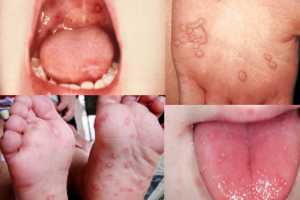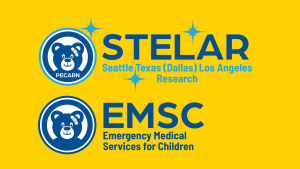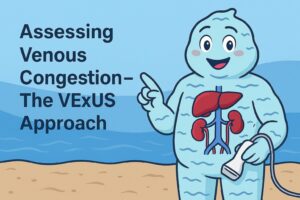Today on the emDOCs cast with Brit Long, MD (@long_brit), we cover esophageal rupture and perforation.
Episode 62: Esophageal Perforation/Rupture
Background:
- Full-thickness tear of the mucosal/muscular layers of the esophagus from sudden increase in esophageal pressure
- Esophagus lacks a serosal layer (more susceptible to perforation)
- With perforation, gastric contents and bacteria extravasate into the mediastinum => mediastinitis, systemic infection, empyema
- Mortality rates reach 90% if not diagnosed and treated
Causes:
- Boerhaave Syndrome: spontaneous rupture, defined as “rupture of the esophagus due to forceful emesis”
- Rapid increase in intraesophageal pressures and opposing negative intrathoracic pressure
- Accounts for 15% of cases
- Most common etiology of esophageal rupture is post endoscopy
- Perforation associated with endoscopy is still very rare
- Other causes: foreign body or caustic ingestion, trauma, tumor, aortic pathology, infection
History and Exam:
- Must consider in patients with chest/abdominal pain
- Evaluate for risk factors (prior esophageal pathology and endoscopic procedures)
- Vomiting classically associated with Boerhaave, but this is just one cause of sudden increase in intraesophageal pressure
- Others: childbirth, seizure, prolonged coughing/laughing, extreme exertion/weightlifting
- Mackler’s triad of Boerhaave syndrome: 1) severe vomiting followed by 2) chest pain and 3) subcutaneous emphysema. Present in less than 50%
- Nausea and vomiting present in less than 20%
- Pain is most common presenting symptom (70%), but depends on perforation location
- Other symptoms also depend on location
- Cervical esophageal perforation – dysphagia and pain with neck flexion; dysphagia is present in 10%
- Thoracic esophageal perforation – chest, back, and/or epigastric pain; dyspnea in 26%
- Distal esophageal perforation with leakage into abdominal cavity – peritonitis and radiation of pain to shoulders as a result of diaphragmatic irritation
- Systemic symptoms occur with severe pain and mediastinal perforation; fever may be delayed (40-50%)
- Subcutaneous emphysema in the neck and/or chest suggestive, but occurs in less than 60% of patients
- Hamman’s crunch: crunching sound over the precordium that occurs with each heartbeat with auscultation of the chest
- Abnormal breath sounds due to pleural effusion or pneumothorax
ED Evaluation
- Labs: Not specific, cannot exclude diagnosis, need imaging
- World Society for Emergency Surgery (WSES) recommends CBC, electrolytes, creatinine, liver function tests, pH, and lactate in the initial evaluation (Grade 1C recommendation).
- Inflammatory markers may be elevated
- Imaging:
- Chest X-ray abnormal in 90%
- May see pneumomediastinum and subcutaneous emphysema
- V sign – air outlining the medial left hemidiaphragm and left lower mediastinal border
- Later findings include pleural effusion (usually left sided), mediastinal air-fluid levels, free air under the diaphragm, hydrothorax, pneumothorax
- Definitive imaging: CT chest with IV contrast or CT esophagography
- CT chest with IV contrast: 92-100% sensitivity; can rule out alternate diagnoses, evaluate for involvement of surrounding structures, guide management
- If suspicious but CT negative, other tests include diagnostic endoscopy or fluoroscopy using water-based contrast
- Chest X-ray abnormal in 90%
Management:
- Broad-spectrum intravenous antibiotics, manage symptoms with antiemetics and analgesics, PPI administration, make patient NPO, consult specialists for definitive therapy
- Specialists include thoracic surgery, interventional radiology, gastroenterology, and critical care
- Several options available for definitive therapy: direct repair and washout, hybrid approach, non-operative
- Primary repair with washout: large perforations, overwhelming mediastinal infection, or large infectious collection formation
- If surgical intervention is necessary but will be delayed and the patient has significant GI material in the pleural cavity with hemodynamic compromise, consider chest tube
- Hybrid approach: minimally invasive, depends on location of the perforation, underlying pathologies, and clinical status of the patient
- Example: GI stent placement, IR fluid drainage, admission to ICU
- Non-operative: patients with early diagnosis and contained leak within the cervical esophagus and/or mediastinum; no abdominal involvement; no signs or symptoms of systemic infection
- Airway: May need airway management if hemodynamically unstable/respiratory distress or with accumulation of profound amounts of subcutaneous air
- Caution with NIPPV: the potential increase in transluminal pressure within the esophagus could potentially worsen the tear, as well as increase subcutaneous air, leading to more difficulty in establishing a definitive airway
- If toxic, respiratory distress, intubation is a good idea
- NG tube placement:
- Place with care and speak with GI/surgeons first; increases in intraluminal pressure from eliciting a gag reflex could theoretically worsen the tear
- Antifungals:
- Some patients may benefit: history of immunocompromise, esophageal lesions or infections, prolonged proton pump inhibitor use, or other risk factors for fungal infection should receive intravenous antifungal coverage such as fluconazole or caspofungin
- Discuss with ID and surgical specialists
Reference:
- DeVivo A, Sheng AY, Koyfman A, Long B. High risk and low prevalence diseases: Esophageal perforation. Am J Emerg Med. 2022 Mar;53:29-36.








